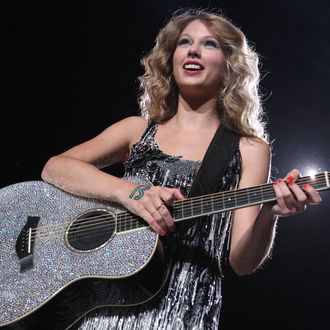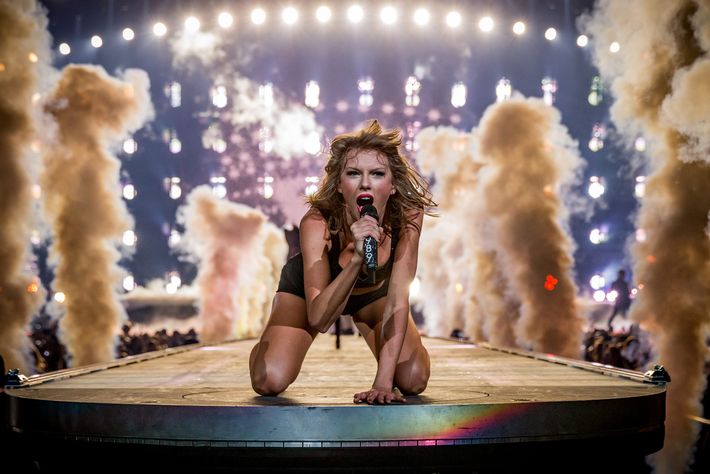
The plot of “Fifteen,” the fourth single off Taylor Swift’s second album, is simple enough. A young girl — not named, but assumed to be Swift herself — has started freshman year at the kind of high school instantly recognizable from eons of suburban pop culture. There are quarterbacks and cute senior boys with cars and cavernous hallways where love has come to bloom and die.
The protagonist, cocksure and full of faith, meets her best friend, a “redhead named Abigail.” (Together the two believe themselves to be, self-consciously yet proudly, outside of the school’s mainstream.) Then she goes on her first date, and she falls in love, and afterward she dances around her room, alone, in pure bliss. By the end there is heartbreak and, with it, the realization of the one truth imperative to this glorious coming-of-age genre: This is not, as it appears to be, the end of the world. Life will be so much bigger than this.
Swift was 18 when Fearless was released, which means she likely wrote “Fifteen” within 24 months of actually being 15. At the time, this confluence of precociousness and craft was seen as elemental to her particular appeal. She was working in the Law & Order ripped-from-the-headlines school of songwriting. Pop songs were invented to mine teen longing. This person was doing the mining in real time.
The high school that Swift references on “Fifteen” does exist. It’s Hendersonville High in Hendersonville, Tennessee, just outside of Nashville. Swift’s family had moved to Hendersonville for her freshman year from Wyomissing, Pennsylvania. The move was a calculated one — Swift had been urging her family toward Nashville, the headquarters of the country-music industry, since hearing the place name-checked, at the age of 10, while watching a Faith Hill special on TV. Swift’s father, a financial adviser at Merrill Lynch, arranged a corporate transfer in order to make it happen. Within two years, Swift’s live schedule meant she could no longer regularly attend Hendersonville High School. She would complete her degree via tour bus tutors.
The best friend is real, too. Her name is Abigail Anderson, and she’d later become a co-star of Swift’s at one time prodigious social-media output. (Anderson’s 25th birthday was particularly exciting. Swift got Chris Carrabba to come do Dashboard Confessional songs and everyone sang along). The last words of the last verse of “Fifteen,” before we hear the chorus one more time, are “And Abigail gave everything she had / to a boy who changed his mind / and we both cried.” It’s a gut punch: Every time I hear it, still, it gets me. I am there, with Taylor and Abigail. I am crying too.
And then I think: This is fucked up. Because it’s not actually Swift’s heartbreak that imparts our bitter truths; it’s Abigail’s. Of Swift’s own budding romance, we hear nothing but cold, savage calculation: “Back then I swore I was gonna marry him some day / but I realized some bigger dreams of mine.” At another point of the song, Swift tells us, “I didn’t know who I was supposed to be / at fifteen,” and it’s enough to make you grin tightly and mutter, “yes you fucking did.” The reality of “Fifteen” is chilling. You think Swift is giving us her tear-stained diary pages in the song. Then you realize Swift is just hoovering up fat lines of Abigail’s raw, uncut pain.
There was a time where I was paid to know about Taylor Swift. Years ago I was a staff writer for this very website and I used to write about her all the time. I still retain some of that knowledge. For one, I can tell you that the minor single “Back to December” is about Swift’s brief, tumultuous relationship with the erstwhile movie actor Taylor Lautner. They broke up in the month of December.
Things changed. I felt I had a pretty good understanding of her, once. At some point, in the last few years, it slipped away. Does Swift genuinely have the emotions she presents? Once, I cared deeply about the answer. Now, I feel blessed to be able to let it go.
Because I don’t mean any of this as critique of the music. The more I listen to “Fifteen,” the more I adore it. It’s a marvel of craftsmanship. That Swift was a real live American teenager writing about real live American teenagers (specifically, the teenager that was her best friend) with the steely-eyed remove and the deadly precision of a jaded, mid-30s, possibly hungover Music Row songwriting lifer is … both weird and incredible?
And on the surface, where I choose to live, it doesn’t matter at all. The simulacra is inspired. “When you’re fifteen / somebody tells you they love you / you’re gonna believe them.” Goddammit, yes. A great, purportedly vulnerable thing came from an unquenchable ambition. In a video interview with the New York Times from around the time Fearless was released, Swift said, with a smile, “I’ve never been more motivated by anything than I am by the sound of people screaming. That’s my favorite sound in the world.”






